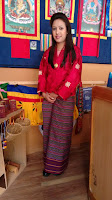(BPD: Life in Bhutan: An executive summary!, 26 Apr -1 Jun '15)
After my stay in Bhutan over the past week, here is what I've gathered about the country. Understandably, this is based on first hand experiences at Thimphu and Paro, but also based on interactions with locals travelling from other parts of the country, and based on the similarity (and simplicity) of life throughout Bhutan.
1. Tourist Season:
 |
| Image source: Drukasia |
2. Administration:
Bhutan has been a monarchy since its unification about a century back, when it used to have several regional satraps. It is now taking baby steps towards democracy, as initiated by the 4th King less than a decade back wherein, only the second elected government is in power. All governance mechanisms of a democracy are slowly taking shape including the new Bhutanese Supreme court building, that was recently inaugurated by Indian Prime minister Modi during his visit to Bhutan. However, the people are uniformly very fond of their Kings, and still not entirely comfortable with the concept of democracy, and hence view it as not-so-essential. Every house and monastery has pictures of the Monarchs and they are worshiped as God.
3. Religion:
 |
| Prayer bell in a school playground, Paro! |
4. People:
 |
| Toddlers, at the back! |
Archery is national sport and archery training fields seen in all parts of the country. Snooker also seems to be of interest, as seen by the numerous parlors that have sprung up. The local language is 'Dzongka', however most people follow and speak basic Hindi, thanks to the influence of Bollywood and the huge dominance of Hindi Entertainment channels in every part of Bhutan. All Indian DTH antenna are very prominently used by people, though its still illegal - all hotels I stayed in provided Sun Direct service!
Almost everyone chews the betel leaf and areca nut, locally called 'doma'. This is hard to miss in Bhutan, and even if you miss the red-stained teeth and lips, the pungent odour would surely hit you. There are blood-like spots of the 'doma' in all places around the country, and one can find people routinely spit on the roads and around the buildings. This was one undesirable thing that stands out against the clean imagery being propagated in Bhutan.
5. Transportation:
 |
| A rare traffic junction, Thimphu city |
I found the taxi drivers to be polite and reasonable, which again took me some time to adjust to, after all the unpleasant conditioning over the years, on our Indian roads. Most taxis are Maruti Alto or Hyundai Santro, while a lot of private vehicles are fancy SUVs.
6. Economy:
 |
| A shopkeeper in 'kera' |
Bhutan produces and sells most of its electricity, produced from the abundant hydropower thanks to its mountain landscape. It also exports Cement and a handful other goods that earn revenue for the country, apart from tourism that also generates some income. The country evidently spends a lot on preserving its culture and is fanatical about conserving the natural environment through sustainable development. All of this is in line with Bhutan's famed GNH policy (Gross National Happiness), as opposed to building an economy around the GNP (Gross National Product) as is the practice world-over.
7. Infrastructure:
 |
| Post office, same architecture again! |
The first thing one would notice about all buildings is the uniformity of all structures, whether its a house, commercial building or even a mall! All of them follow the traditional Bhutanese architecture, as dictated by the Driglam Namzha. The cities are green and clean with enough trees planted (or rather not cut off). The government has taken care to place dustbins every few metres throughout the city, and more at tourist places - this is in line with Bhutan's target to achieve Zero Waste by 2030. Overall, there are no flashy signs of development or grandeur, even the capital Thimphu looks like a big, but pretty ordinary city.
 |
|
| 'Penis' on house walls, a common sight! | 'Phallus' dolls.. just to ward off evil spirits |

No comments:
Post a Comment